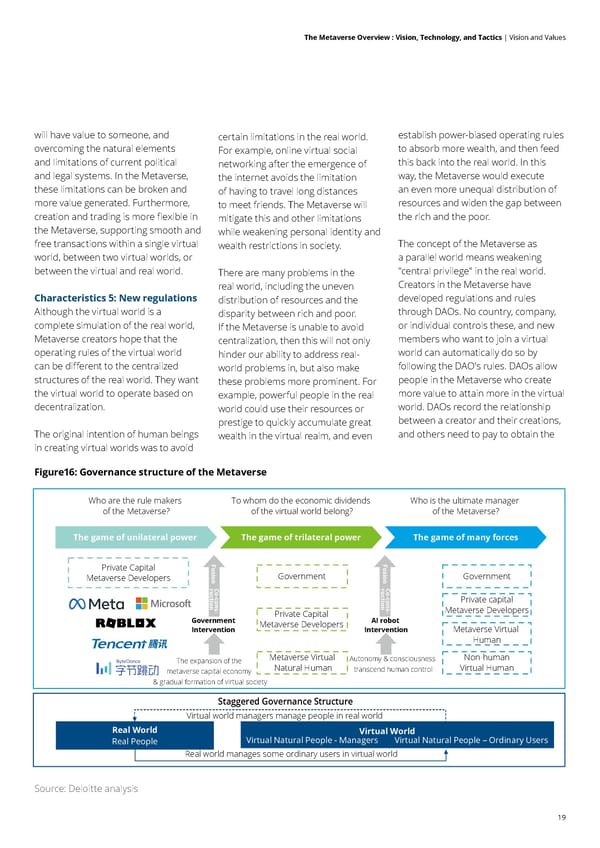19 The Metaverse Overview : Vision, Technology, and Tactics | Vision and Values will have value to someone, and overcoming the natural elements and limitations of current political and legal systems. In the Metaverse, these limitations can be broken and more value generated. Furthermore, creation and trading is more flexible in the Metaverse, supporting smooth and free transactions within a single virtual world, between two virtual worlds, or between the virtual and real world. Characteristics 5: New regulations Although the virtual world is a complete simulation of the real world, Metaverse creators hope that the operating rules of the virtual world can be different to the centralized structures of the real world. They want the virtual world to operate based on decentralization. The original intention of human beings in creating virtual worlds was to avoid certain limitations in the real world. For example, online virtual social networking after the emergence of the internet avoids the limitation of having to travel long distances to meet friends. The Metaverse will mitigate this and other limitations while weakening personal identity and wealth restrictions in society. There are many problems in the real world, including the uneven distribution of resources and the disparity between rich and poor. If the Metaverse is unable to avoid centralization, then this will not only hinder our ability to address real- world problems in, but also make these problems more prominent. For example, powerful people in the real world could use their resources or prestige to quickly accumulate great wealth in the virtual realm, and even establish power-biased operating rules to absorb more wealth, and then feed this back into the real world. In this way, the Metaverse would execute an even more unequal distribution of resources and widen the gap between the rich and the poor. The concept of the Metaverse as a parallel world means weakening "central privilege" in the real world. Creators in the Metaverse have developed regulations and rules through DAOs. No country, company, or individual controls these, and new members who want to join a virtual world can automatically do so by following the DAO's rules. DAOs allow people in the Metaverse who create more value to attain more in the virtual world. DAOs record the relationship between a creator and their creations, and others need to pay to obtain the Figure16: Governance structure of the Metaverse Source: Deloitte analysis Who are the rule makers of the Metaverse? Who is the ultimate manager of the Metaverse? To whom do the economic dividends of the virtual world belong? The game of unilateral power The game of trilateral power The game of many forces AI robot Intervention Government Private capital Metaverse Developers Metaverse Virtual Human Non-human Virtual Human Private Capital Metaverse Developers Government Private Capital Metaverse Developers Metaverse Virtual Natural Human Government Intervention Fusion Co-cons- ruction Autonomy & consciousness transcend human control The expansion of the metaverse capital economy & gradual formation of virtual society Staggered Governance Structure Real World Virtual World Virtual world managers manage people in real world Real People Virtual Natural People – Ordinary Users Virtual Natural People - Managers Real world manages some ordinary users in virtual world Fusion Co-cons- ruction
 Deloitte The Metaverse Overview Page 18 Page 20
Deloitte The Metaverse Overview Page 18 Page 20